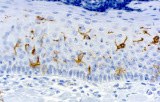
Anti-CD1a CE/IVD for IHC - Hematopathology
At least five CD1 genes (CD1a, b, c, d, and e) are identified. CD1 proteins have been demonstrated to restrict T cell response to non-peptide lipid and glycolipid antigens and play a role in non-classical antigen presentation. Cluster of Differentiation 1a (CD1a) is part of a family of major histocompatibility complex (MHC) antigen-like glycoproteins that associate with beta-2-microglobulin. CD1a binds self and non-self lipid and glycolipid antigens, presenting them to T-cell receptors on natural killer T cells. Anti-CD1a labels Langerhans cell histiocytosis (Histiocytosis X), extranodal histiocytic sarcoma, a subset of T-lymphoblastic lymphoma/leukemia, and interdigitating dendritic cell sarcoma of the lymph node. When combined with antibodies against TTF-1 and CD5, anti-CD1a is useful in distinguishing between pulmonary and thymic neoplasms since CD1a is consistently expressed in thymic lymphocytes in both typical and atypical thymomas, but only focally in 1/6 of thymic carcinomas and not in lymphocytes in pulmonary neoplasms.


Tonsil section
Thymus section
Search result : 3 product found
Refine your search :
RUOCE / IVD
- Primary antibody
- IHC 3
- IHC530 3
Cat#
Description
Cond.
Price Bef. VAT
‹
›


